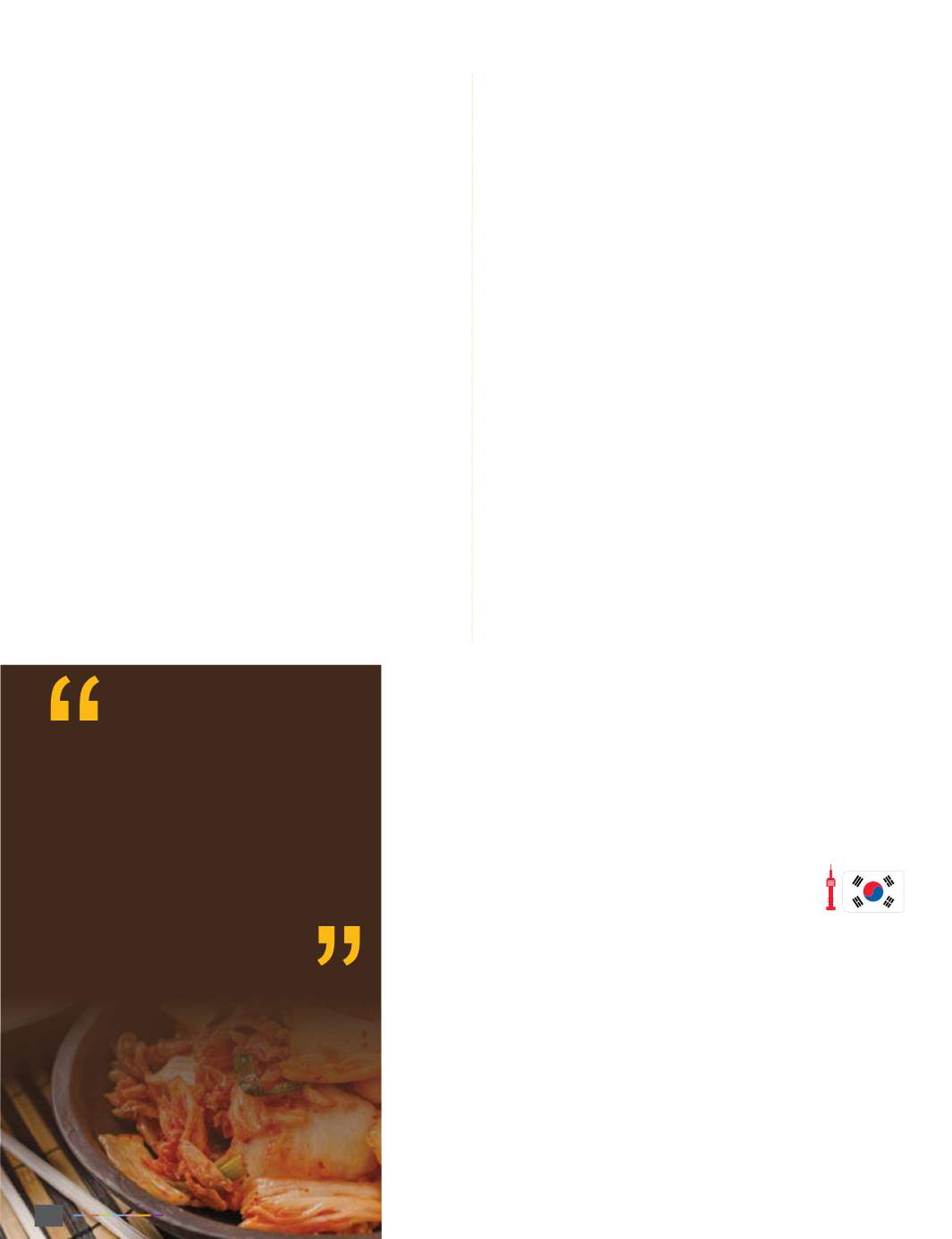
Food FocusThailand
DECEMBER 2015
36
• Professor Park Tae-gyoun
Graduate School of Food and Drug Administration
of Chung-Ang University
Food and Drug Columnist
อาหารในราชส�
ำนั
กจั
ดเป็
นคริ
สตั
ลของวั
ฒนธรรมอาหารดั้
งเดิ
ม (Crystalof traditional
foodculture)จั
ดเสิ
ร์
ฟเป็
นเซ็
ตวางบนโต๊
ะส�
ำหรั
บกษั
ตริ
ย์
เรี
ยกว่
าSooraSangมี
เครื่
องเคี
ยง
หลากหลาย 12 รายการ เช่
น ผั
ก อาหารทะเลหมั
กด้
วยเกลื
อ เป็
นต้
น จั
ดเสิ
ร์
ฟ 5 มื้
อต่
อวั
น
(มื้
อละไม่
มาก) อาหารในวั
งมี
คุ
ณสมบั
ติ
5ประการ คื
อ
• อาหารและวิ
ธี
ปรุ
งมี
ความหลากหลาย
• ไม่
ใช้
ผั
กและปลาที่
มี
รู
ปร่
างไม่
สวยงาม
• อิ
นกรี
เดี
ยนท์
ที่
ใช้
ต้
องให้
กลิ่
นรสแท้
ๆของอิ
นกรี
เดี
ยนท์
นั้
นๆ
• ปรุ
งอาหารตามสู
ตรและข้
อบั
งคั
บด้
วยความพิ
ถี
พิ
ถั
น
• เป็
นอาหารที่
ดี
ต่
อสุ
ขภาพของกษั
ตริ
ย์
อาหารในวั
ดเป็
นมั
งสวิ
รั
ติ
คื
อ ข้
าวกั
บผั
กต่
างๆ โดยยกเว้
นผั
ก 5 ประเภท เช่
น ต้
นหอม
(Green onion) กระเที
ยม (Garlic) กระเที
ยมหอม (Leek) กระเที
ยมป่
า (Wild chive) และ
Chinese squill ที่
เชื่
อว่
าจะก่
อให้
เกิ
ดความก�
ำหนั
ด ไม่
ใช้
ข้
าวขาวเพราะเชื่
อว่
าไม่
มี
คุ
ณค่
า
ทางโภชนาการกิ
นน้
อย เครื่
องเคี
ยงน้
อยวั
ตถุ
ดิ
บน้
อยโดยมี
3อย่
างคื
อรากบั
ว (Lotus root)
เป็
นสั
ญลั
กษณ์
สื
่
อถึ
งพุ
ทธศาสนา โกโบหรื
อส่
วนของรากไม้
ตระกู
ลหญ้
าเจ้
าชู
้
(Burdock)
และสมุ
นไพรพื
ชตระกู
ลเบญจมาศ (Butterbur)
อาหารในตระกู
ลหรื
อชงกา (Jong Ga) สื
บทอดโดยสะใภ้
ของลู
กชายคนโตของ
ตระกู
ลนั้
นๆคนเกาหลี
มี
ความเข้
าใจว่
าอาหารของตระกู
ลมี
ความยุ่
งยากซั
บซ้
อน ไม่
ถู
กปาก
คนปั
จจุ
บั
น และมี
เครื่
องเคี
ยงเยอะเต็
มโต๊
ะ จึ
งมี
การปรั
บเปลี่
ยนให้
ถู
กปาก ใช้
เครื่
องเคี
ยง
น้
อยลงและเน้
นอาหารแบบSlow food
ทั
้
งนี้
นโยบายด้
านอาหารของเกาหลี
ยั
งไม่
เป็
นหนึ่
งเดี
ยวนั
ก จึ
งอยากจะสร้
างความ-
ร่
วมมื
อกั
บประเทศในเอเชี
ย เช่
น จี
น ญี่
ปุ
่
น ไทย เพื่
อสร้
างเครื
อข่
ายของนั
กวิ
ชาการและ
สื่
อมวลชนด้
านอาหาร
canstill represent their trueorigins,suchasStir friedspaghettiwithdriedGourami,
rotiwithgreencurrychicken, and fusion foods (foods that leaveno trace towhat
they were originated from, such as cheese curry whose taste and look would
not give out its two native origins.)
• SirintraBoonsumrej
ManagingEditor, FoodFocusThailandMagazine
According to data fromMinistry of Agriculture and Cooperatives, Thailand
issituated in the tropical area,whereaverage temperature isbetween25-37
o
C,
with 80-85% humidity. The country is highly rich in natural resources with
agricultural area of 46.54% of the whole landmass; divided into rice fields
(46.90%), gardens and orchards (23.39%), cultivated farmlands (20.87%) and
vegetable farmsandflowergardens (0.93%)andotheragricultural lands (7.91%).
Thailand’s famous chef, McDang, used to give definition to Thai food as
thesewordscome tomind: intricacy; attention todetail; texture; color; taste; and
the use of ingredients withmedicinal benefits, as well as good flavor. We not
only pay attention to how a dish tastes: we are also concerned about how it
looks, how it smells, and how it fits inwith the rest of themeal. We think of all
partsof themeal asawhole -SumRapThai (thewayThaiseat), is the termwe
use for the unique components that make upa characteristicallyThai meal.
Recipesof Thai cuisineshavebeenmodified through times, attuning to the
changing preferences of societies. Lifestyles of Thai people now have greatly
changed from living inacompound family toasingle family,wheremost people
works away fromhomeand rarely prepares their ownmeals anymore. Inorder
to answer to thismodern trend, various instant Thai foods have been created,
such as TomYum (hot and spicy soup), Kaeng KeawWan (GreenCurry) and
Massamun curry.Another good example is the Instant FriedRice, created and
developed by Institute of Food Research and Product Development (IFRPD)
KasetsartUniversity.Theproductwon the1
st
prize from theThaiRice Innovation
Contest2007,heldbyThaiRiceFoundationunderRoyalPatronage.The instant
herbal rice nuggets contain rice, herbs and spices as major ingredients. Four
formulas nuggets including “Kang leung”, “Kang keaw wan”, “Kao mok”, and
“Kaeng kua” were shaped into flat and round pieces, breaded, par-fried at
170-180
o
C for 30 seconds, and then kept frozen at -18
o
C .
With the hope to promote Thailand as the Kitchen of the World, Thai
Government has planned to systematically organize the expansion of Thai
restaurants worldwide which will be good for Thailand’s image, tourism and
export.
Moreover,Department of International TradePromotion,MinistryofCommercehas initiated
thecampaign “Thai SELECT” topublicizeandpromoteThai food in internationalmarketwith the
symbol “ThaiSELECT”.Thissymbolwillbeacertificateofquality for restaurants -both inThailand
andworldwide-andReady-to-EatThai foodproducts, inorder toestablishconfidenceandassure
the highquality of Thai restaurants andRTEproducts in international foodarena.
Geographical Indication (GI) isyetanotherproject topromoteThai cuisines. Certainproducts
fromspecificplacesof originarebeingmarketed tohighlight their uniqueness, suchasJasmine
rice fromThungKulaRongHai (KhaoHomMali ThungKulaRongHai)whichcanonlybegrown
in the area of Kula Rong Hai field: stretching over 2,107,690 Rai (3,372 Sq.Km.), in Maha
Sarakham, Roi Et, Yasothon, Surin, andSi SaKet province.
On 23October 2006, SangyodMuang Phatthalung Rice was announced to be Thailand’s
first rice breed under Geographical Indication (GI) andwas granted the name “Khao Sangyod
MuangPhatthalung”
Perspectives from Land of Ginseng:
SOUTH KOREA
• Professor Dr.HyeGyung Jeong
FoodandNutritionMajor, HoseoUniversity
Intangible cultural heritage is the embodiment of innovation, creativity, intellect, diversified
knowledgeandcultivation. Ithasbeenpasseddown throughgenerationsandneeds tobecarefully
preserved andappreciated.
Intangible cultural heritages can be classified into3 categories:
1. Traditional Parades: art performances, includingmusic, danceandentertainment
2. FoodManufacturing: Royal cuisine, Ceremony cuisine, andFolk cuisine.
3. Handicraft
Asoneof the three intangibleculturalheritages, foodhasalwayshadhuge influence towards
eachnation’sculturesandhasbeenpasseddown fromgeneration togeneration.Korean traditional
food or Hansik is Korea’s cultural heritagewith cultural value (cookingmethods & techniques),
economicvalue (sourceofculture),andvalueas thecountry’sbrand (touristspots).SouthKorea’s
governmental and private sectors have jointly conducted an integrated campaign to promote
Korean food, such as publicizing food to boost up tourism, presenting Korean food as healthy
foodwith regards to seasonings, rawmaterialsand cookingprocess, and settinghigh criteriaof
over20yearsofexperiencewith food for thosewhowish to registerasaKoreanTraditionalFood
Master.
Culinarycultures
arevery important
legacies of every nation that need to
bewellacknowledged,preservedand
promoted.
Eachcountry’s
National cuisines have their
ownuniqueness
anddeserve tobe
proudof by its people.


